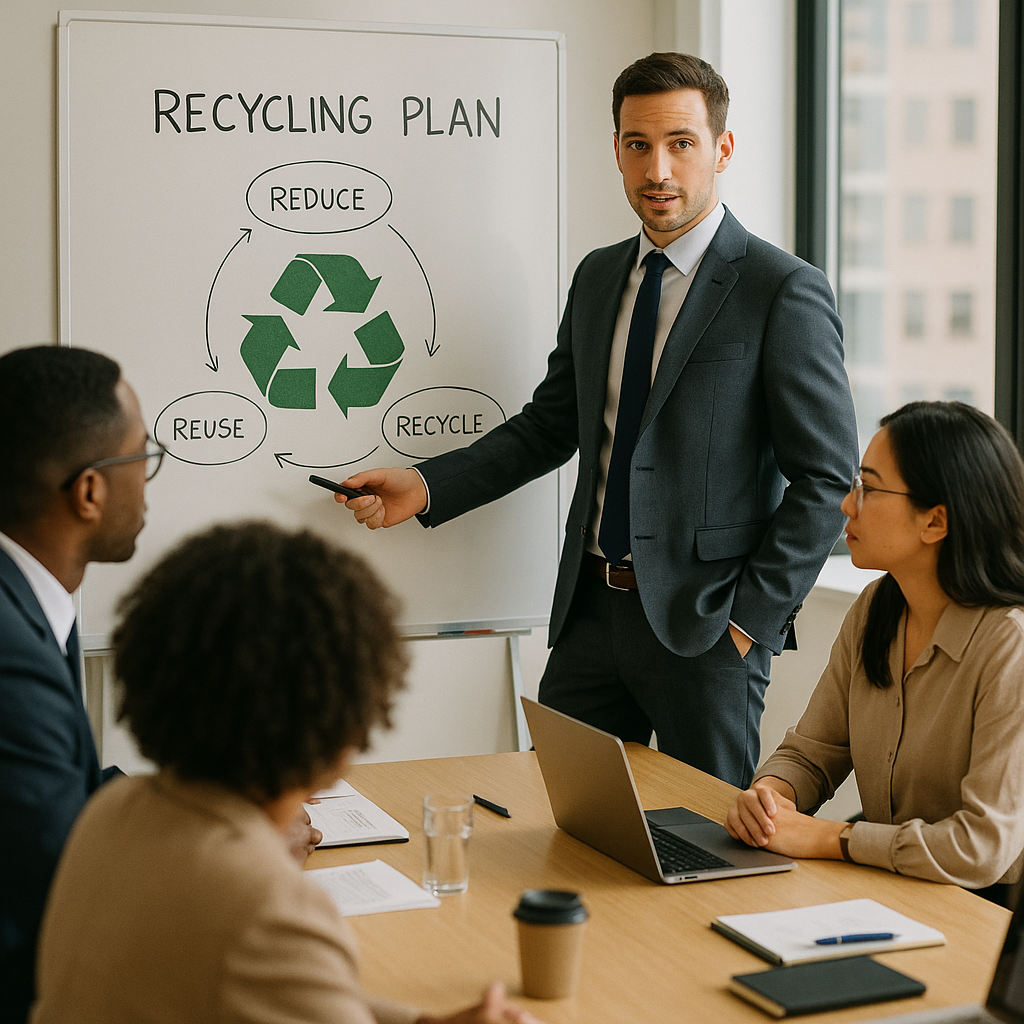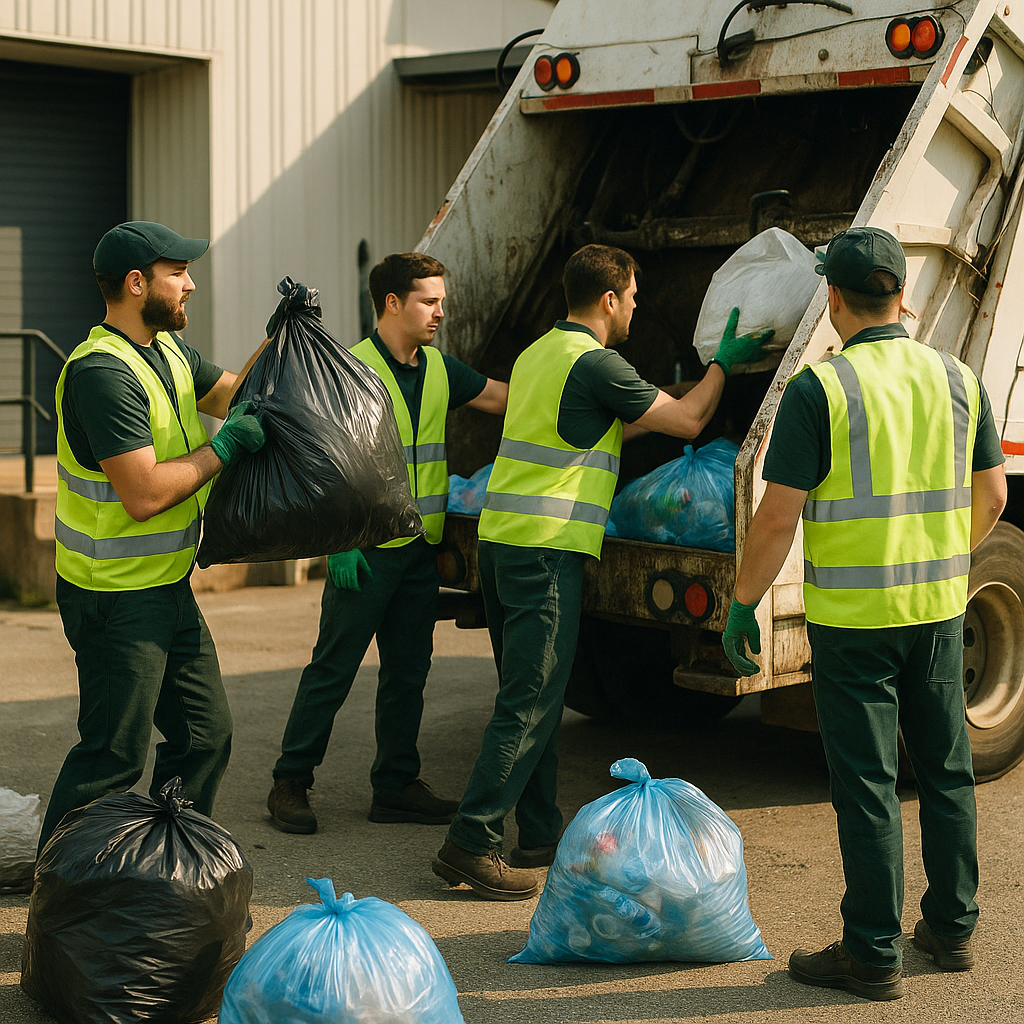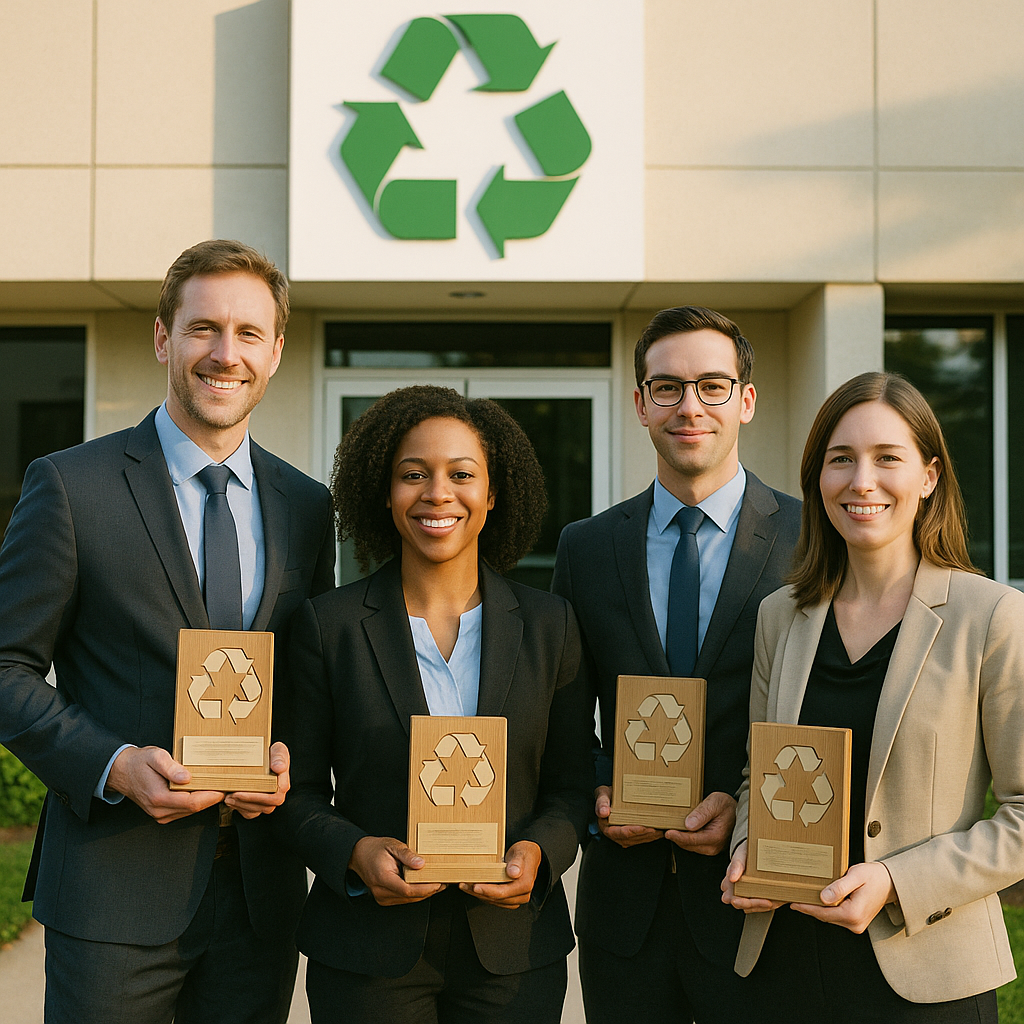5901 Botham Jean Blvd, Dallas, TX 75215
Commercial Waste: What it Means and How to Manage It
July 22, 2025Every business generates waste. From crumpled drafts in a lawyer’s office to empty packaging at a retail store, commercial waste encompasses all materials discarded during business operations. It refers to any waste generated by a business through commercial activity, regardless of size or industry.
This waste category includes materials from stores, offices, restaurants, warehouses, and non-manufacturing activities at industrial facilities. Even home-based entrepreneurs should be aware that any waste produced from their business activities counts as commercial waste, not household trash. This distinction carries legal implications for proper disposal.
Understanding commercial waste is the first step toward responsible management. Business owners face different regulations and disposal requirements than residents, making proper identification essential for compliance and environmental stewardship.
What Types of Waste are Considered Commercial?

Commercial waste includes all solid waste generated by businesses during operations. Unlike residential waste, commercial waste is typically more varied and often produced in larger volumes. Understanding the different categories of commercial waste is essential for proper management and disposal.
General Office Waste
Businesses produce significant amounts of general office waste daily. This includes paper documents, newspapers, magazines, and various paper products common in offices. Additionally, it covers items like plastic bottles, food containers, and disposable cups used throughout the workday.
Despite being highly recyclable, much of this waste ends up in landfills due to inadequate sorting practices. Implementing effective recycling programs can significantly reduce the environmental impact of these waste streams.
Retail and Packaging Waste
Retail businesses generate substantial packaging materials, including cardboard boxes, plastic wrapping, styrofoam padding, and various protective materials. Food retailers also produce significant amounts of food wrappers, containers, and disposable serving items.
Cardboard is one of the most recyclable materials in this category and an excellent target for recycling initiatives. Reducing packaging waste through sustainable alternatives can help businesses lower their environmental footprint.
Construction and Demolition Waste
The construction industry produces large volumes of waste during building, renovation, and demolition projects. This includes concrete, bricks, wood scraps, glass, metal, drywall, and insulation materials. Construction waste often constitutes a significant portion of commercial waste by weight and volume.
Many construction materials can be recycled or repurposed. Concrete can be crushed and used as aggregate, while wood can become mulch or biomass fuel, reducing landfill contribution.
Industrial and Manufacturing Waste
Manufacturing facilities produce various waste streams depending on their production processes, including scrap metal, plastic trimmings, wood shavings, fabric remnants, and rejected products. Proper sorting is essential for effective recycling due to the diversity of this waste category.
Industrial waste management often requires specialized handling to maximize resource recovery and minimize environmental impact. Many manufacturing byproducts can become valuable inputs for other industrial processes.
| Type of Commercial Waste | Recyclable | Non-Recyclable |
| Paper/Cardboard | X | |
| Electronic Waste | X | |
| Hazardous Waste | X | |
| Construction Waste | X | |
| Food Waste | X (Compost) | |
| Glass | X | |
| Plastic | X | |
| Metal | X |
Food and Organic Waste
Restaurants, cafeterias, grocery stores, and food processing facilities produce significant food waste, including food scraps, spoiled produce, expired products, and preparation remnants. Food waste decomposes in landfills, releasing methane, a potent greenhouse gas.
Diverting food waste through composting or anaerobic digestion creates valuable soil amendments and reduces methane emissions. Some businesses also partner with food recovery programs to donate edible excess food to those in need.
Hazardous Commercial Waste
Many businesses generate hazardous waste requiring special handling and disposal procedures. This includes chemicals, solvents, paints, oils, batteries, and electronic waste containing toxic components. Improper disposal of these materials can cause environmental contamination and health risks.
Hazardous waste management is strictly regulated, and businesses must follow specific protocols for storage, transportation, and disposal. Specialized waste management services ensure these materials are handled safely and in compliance with regulations.
Agricultural Waste
Farming operations produce unique waste, including crop residues, animal waste, pesticide containers, and used agricultural plastics. While much agricultural waste is organic and biodegradable, some components require specialized handling.
Many agricultural wastes can be composted or used for energy generation through biogas systems. Proper management of agricultural waste helps prevent soil and water contamination while recovering valuable resources.
What are Businesses’ Responsibilities Regarding Commercial Waste?

Businesses face several mandatory obligations when managing commercial waste. Understanding these responsibilities is essential for legal compliance, environmental stewardship, and operational efficiency.
Waste Minimization and Reduction
A primary responsibility for businesses is minimizing waste generation at its source. This involves evaluating production processes, purchasing decisions, and daily operations to identify opportunities for reducing waste.
Implementing waste reduction strategies helps save on disposal costs and reduces the environmental footprint. Actions like switching to digital documentation or purchasing supplies with minimal packaging can significantly decrease waste volume.
Safe and Secure Waste Storage
Businesses must store all commercial waste in appropriate containers to prevent environmental contamination. This includes using containers with proper covers to protect waste from weather conditions such as wind and rain.
Waste storage areas should be clearly labeled to show the types of waste contained. This prevents cross-contamination and ensures employees know where to place specific waste materials.
Documentation and Compliance
Legal documentation is a critical aspect of commercial waste management. Businesses must complete waste transfer notes for each load of waste leaving their premises, maintaining these records for at least two years.
These documents create an audit trail, proving proper waste handling. They include details about waste type, quantity, and destination, serving as essential evidence of regulatory compliance.
Proper Carrier Selection
Businesses have a legal obligation to ensure their waste is collected by registered waste carriers. This verification process helps prevent illegal waste disposal and ensures waste is transported to appropriate facilities.
Working with licensed waste management companies protects businesses from potential liability if waste is improperly disposed of after collection. Always request registration documentation before contracting with a waste carrier.
Hazardous Waste Management
Special regulations apply to hazardous waste, including materials like batteries, chemicals, oils, and electronic equipment. Businesses must identify, segregate, and handle these materials according to specific regulations.
Hazardous waste requires separate storage from regular commercial waste to prevent contamination. Businesses generating hazardous waste must follow protocols for packaging, labeling, and disposal through certified hazardous waste disposal services.
Recycling Implementation
Effective recycling programs are another key responsibility. Many localities now require businesses to recycle specific materials such as cardboard, paper, glass, and plastics.
Food waste recycling has become increasingly important, with some jurisdictions mandating separate collection of organic materials. Businesses should establish clear recycling systems with appropriate bins and signage to maximize material recovery.
Employee Training and Engagement
Proper waste management requires participation from all staff members. Businesses must educate employees about waste sorting procedures, recycling guidelines, and the importance of compliance.
Regular training sessions ensure everyone understands their role in the waste management process. Creating a green team can promote waste reduction initiatives and monitor program effectiveness throughout the organization.
How Should Businesses Manage their Commercial Waste?

Effective commercial waste management is critical for businesses to maintain compliance with regulations, reduce environmental impact, and potentially lower operational costs. Understanding your waste stream and implementing proper handling procedures are essential first steps toward responsible waste management.
Conduct waste audits
A waste audit is a systematic review of your business operations to identify the quantity and composition of materials in your waste stream. This crucial first step helps you tailor your waste reduction program effectively.
Start by examining your trash and recycling bins to determine the types of waste your business generates most frequently. Document the findings and use this data to establish a benchmark for future improvement. Some local governments and waste haulers offer free waste audits to businesses, so check with your municipality for available resources.
Implement comprehensive recycling programs
Based on your waste audit findings, develop a recycling program tailored to your specific waste stream. An effective recycling program includes:
- Clear signage on bins with pictures indicating what items belong where
- Strategic placement of recycling bins next to trash containers
- Consistent color-coding (e.g., blue for recycling, green for compost, black for trash)
- Regular communication and education for employees
- Recognition of recycling achievements to maintain momentum
Employee engagement is crucial to program success. Provide training on proper sorting practices and explain why recycling matters for both the business and the environment. Consider appointing recycling champions within different departments to encourage participation.
Proper waste storage and handling
Safe storage of waste materials prevents contamination, reduces accident risks, and ensures compliance with regulations. Follow these best practices:
For general waste and recyclables:
- Use durable, leak-proof containers suitable for the volume and type of waste
- Keep all containers closed when not in use to deter pests and reduce odors
- Store containers in well-ventilated areas away from direct sunlight
- Inspect containers regularly for damage or leaks
- Ensure adequate space between containers for easy access and inspection
For hazardous waste:
- Store in compatible containers specifically designed for the material
- Clearly label all containers with contents and hazard information
- Keep incompatible materials separated to prevent dangerous reactions
- Store heavy items on lower shelves to prevent falling hazards
- Maintain appropriate spill containment measures
Hazardous waste management
Businesses that generate hazardous waste have special obligations under federal and state regulations. Hazardous waste includes materials that are ignitable, corrosive, reactive, or toxic.
First, determine your generator category based on the amount of hazardous waste produced monthly: Very Small Quantity Generator (VSQG), Small Quantity Generator (SQG), or Large Quantity Generator (LQG). Your category determines the applicable regulations.
Key requirements for hazardous waste generators include:
- Obtaining an EPA identification number (for SQGs and LQGs)
- Following strict accumulation time limits (180 days for most SQGs)
- Properly labeling all containers with the words “Hazardous Waste” and identifying hazards
- Training employees on proper handling procedures
- Preparing waste for shipment according to Department of Transportation regulations
- Using licensed hazardous waste transporters and disposal facilities
- Maintaining thorough documentation and records
Remember that improper disposal of hazardous waste can result in significant penalties and environmental liability.
Partner with registered waste carriers
Choose reputable, licensed waste management partners to ensure your waste is handled properly. When selecting vendors, consider:
- Proper licensing and permits for handling your specific waste types
- Compliance history and environmental track record
- Available recycling and recovery options
- Clear pricing and service agreements
- Reporting capabilities to track your waste management performance
Request documentation of proper disposal and maintain these records. Remember that even when using third-party waste services, your business remains ultimately responsible for proper waste management.
Waste reduction strategies
The most effective waste management strategy is to generate less waste initially. Consider these waste prevention approaches:
- Review purchasing practices to minimize excess packaging
- Implement paperless systems where possible
- Choose durable, reusable items over disposable ones
- Work with suppliers to reduce packaging waste
- Donate usable items rather than discarding them
- Repurpose materials within your operations when possible
Track your waste reduction progress over time to demonstrate environmental and financial benefits to stakeholders.
Monitor and improve continuously
Effective waste management is an ongoing process. Regularly evaluate your program’s performance against established goals and make adjustments as needed. Use tracking systems to monitor waste generation, recycling rates, and disposal costs.
Consider establishing annual waste reduction targets and publicly sharing your progress. This transparency demonstrates your commitment to environmental stewardship and can enhance your business reputation.
| Generator Category | Description | Requirements |
|---|---|---|
| Large Quantity Generators (LQGs) | Generate 1,000 kilograms per month or more of hazardous waste, more than 1 kilogram of acutely hazardous waste, or more than 100 kilograms of acute spill residue or soil. | Must comply with extensive regulations, including notification, record keeping, and training requirements. |
| Small Quantity Generators (SQGs) | Generate more than 100 kilograms but less than 1,000 kilograms of hazardous waste in a calendar month. | Obliged to adhere to specific accumulation time limits and training requirements. |
| Very Small Quantity Generators (VSQGs) | Generate 100 kilograms or less of hazardous waste, or 1 kilogram or less of acutely hazardous waste, or 100 kilograms or less of acute spill residue or soil in a calendar month. | Subject to simpler requirements but should ensure proper disposal and may require state notifications. |
By implementing these comprehensive waste management practices, businesses can reduce their environmental impact, maintain regulatory compliance, and potentially realize significant cost savings through reduced disposal fees and more efficient resource use.
Conclusion: Importance of Proper Commercial Waste Management

Proper management of commercial waste is more than a legal requirement; it’s a crucial environmental and social responsibility with extensive impacts. By implementing effective waste management strategies, businesses contribute to environmental conservation by reducing pollution, minimizing landfill use, and conserving valuable natural resources. These practices help build a sustainable future for communities while showcasing corporate responsibility.
Beyond environmental benefits, proper waste management offers tangible advantages for businesses. Companies focusing on waste reduction and recycling often achieve cost savings through reduced disposal fees and efficient resource use. Regulatory compliance helps prevent fines and legal issues that can harm finances and reputation. For forward-thinking organizations, effective waste management is not just about problem avoidance—it’s about embracing opportunities to operate sustainably and potentially improve profitability.
For businesses looking to enhance their waste management practices, contact Okon Recycling at 214-717-4083. Our team can help you develop customized solutions that align with your specific business needs while promoting environmental sustainability.
